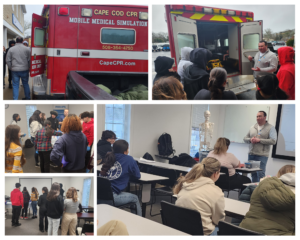Medical Academy Students Learn Real-World Career Skills During Bioskills Lab at Cape Cod CPR
 Seniors, juniors, and sophomores in the Medical Academy got to see first-hand how the human heart and lungs function during a field trip to Cape Cod CPR in South Yarmouth.
Seniors, juniors, and sophomores in the Medical Academy got to see first-hand how the human heart and lungs function during a field trip to Cape Cod CPR in South Yarmouth.
Medical Academy instructor Jennifer Santos also teaches EMT courses at Cape Cod CPR, so she arranged for her students to travel to the Cape for the day to attend a bioskills lab at the facility.
The team at Cape Cod CPR set up three stations for students: a cardiac station, a pulmonary station, and an ambulance station. At the cardiac station, students observed the dissection of a 57-year-old female’s heart who died from liver cirrhosis and were able to touch the heart.
For senior Fernando Barbosa, this was the first time he saw real human body parts.
“It was exhilarating to learn about your airway and see what a heart looks like after too much McDonald’s,” Barbosa said.
At the pulmonary station, students reviewed airway equipment with a simulation mannequin and observed a ventilator being administered on the mannequin. They also observed and touched a pig’s lungs and the lungs of a 64-year-old male smoker. They were able to inflate and deflate the lungs using a bag valve mask.
Students also reviewed vital signs and the equipment used to measure them, and they learned about Basic Life Support medications that can be administered in an ambulance. They also got to tour an ambulance.
“Many students were fascinated by the experience and it triggered a fire in them to continue pursuing a career in the healthcare field,” Santos said. “It’s one thing to sit in a classroom and learn about human anatomy. It’s another thing entirely to be able to see and touch real human parts. This brings their Medical Academy experience to a whole new level.”
“This was an amazing hands-on experience,” Barbosa said. “We spend so much time in class taking notes, but here we got to prove what we know.”
Atlantis welcomed Jennifer Santos to the teaching staff in November. Santos has been a paramedic for 20 years for both private ambulance services and municipalities, working her way up to a director’s position. She has also taught EMT and paramedic courses and American Heart Association courses for 12 years.
She teaches four classes in the Medical Academy: Fundamentals of Healthcare I for sophomores, Patient Assessment for juniors, Body Systems Applications for seniors, and an elective anatomy class. Each class is based on a part of a basic EMT course.
“The goal is by the time students graduate, they will have gone through an entire EMT course,” Santos said. “They would be well-prepared for an EMS career. Students going into nursing would also have the foundation needed to take nursing school entrance exams.”
Barbosa says the Medical Academy has prepared him well for his future career as a travel nurse, “Just this year alone, I have learned way more than in the past. I feel like you could put scrubs on me right now, and I can save some lives.”
Medical Academy students recently completed an American Heart Association CPR class, so they are CPR certified for two years. This spring, seniors will complete a capstone project. Some will take part in internships at Fall River EMS and St. Anne’s Hospital, completing 6 to 10 hours a week between March and May. Others will complete a healthcare-related research project. Santos hopes to set up one or two ambulance ride-along shifts for students completing a research project, so they get a better feel for emergency medicine.